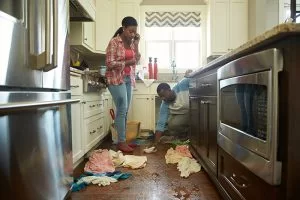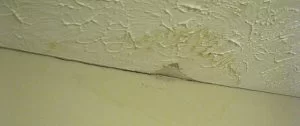Any time you discover water damage in your home or building, it’s important to notify a water damage restoration professional as quickly as possible. Doing so will limit the amount of damage to the building materials and items, cut down on the time it takes to restore the area, and save you money during the restoration process. Especially if the water continues to flow into your home or business, cutting off the water source and contacting a local contractor is essential.
As water damage worsens over time, there is also the threat of mold growth on the wet materials. In the presence of excess moisture or water damage, the natural mold spores in the air will accumulate within the wet area and begin feeding on the affected material. This is why it’s critical to have it dried out as quickly as possible.
For those wondering whether or not to allow their wet walls to dry out, it takes about three days. Although the extent of the water damage will ultimately determine how long it will take for your situation. Regardless, mold only takes 24 hours to grow, so there is a chance that it will start while your drywall is drying.
The following is information on how long it takes wet drywall to dry, what to account for, and how to more effectively dry the drywall.
Factors Affecting Drying Time
Extent of the Damage
 This is common sense, but you should know that the more water that soaks into the drywall, the more time it will require to dry out. Especially if the drywall’s been soaked, it will take incredibly long to dry out completely.
This is common sense, but you should know that the more water that soaks into the drywall, the more time it will require to dry out. Especially if the drywall’s been soaked, it will take incredibly long to dry out completely.
This is why it often takes longer to restore flood damage compared to mild water damage after a pipe leak.
Drying Technique
It’s important to dry out wet drywall as quickly as possible and there are several methods to do this. When only relying on one, it will take longer. By using various units of equipment and opening doors and windows, things will move a little quicker.
When using multiple units of dehumidifiers and air movers, more moisture will be extracted from the drywall while preventing mold growth on the drying materials. It’s also good to open the exterior windows and doors to allow for better air flow.
Wall Covering
 As you can imagine, paint is porous just like drywall, and the more paint on the drywall, the longer it will take to dry when wet. Wallpaper is another issue when dealing with wet drywall; it most likely will not dry well. Lastly, there’s the issue of multiple wallboard layers taking longer to dry out.
As you can imagine, paint is porous just like drywall, and the more paint on the drywall, the longer it will take to dry when wet. Wallpaper is another issue when dealing with wet drywall; it most likely will not dry well. Lastly, there’s the issue of multiple wallboard layers taking longer to dry out.
Openness of the Wall
When water damage occurs to your drywall, it can be damaged from both the front and back ends. In these situations, the wall should be opened on both sides to allow for efficient drying, which can still take up to a few weeks. Otherwise, you’re looking at months, and by then, you’ll be sure to find mold growth.
How to Dry Out Damaged Walls
Remove All Building Materials
As mentioned above, it’s best to remove the wall to allow it to dry on both sides which accelerates the drying time. You may also want to consider removing any moldings, baseboards, and trim while setting up the drying equipment. This will also prevent moisture and mold spores from becoming trapped between the materials and the wall.
And of course, any wallpaper should be removed from drying walls.
Set Up Drying Equipment and Increase Air Flow
 Weather permitting, open all exterior windows and doors to allow for more efficient air flow.
Weather permitting, open all exterior windows and doors to allow for more efficient air flow.
Then set up fans and dehumidifiers to improve air flow around the drying drywall. Anything and everything will help. But even if you don’t have fans or equipment, consider purchasing or renting the equipment from your local hardware store. It will be worth it.
Work with a Professional
While some cases of water damage can be managed at home or by one’s self, others are more severe, such as the case with standing water. When the amount of water in the affected area becomes overwhelming or you feel you are in over your head, it’s time to contact the professionals with the industrial equipment.
 When working with a water restoration contractor, you can expect the drying process to be much more efficient than with fans around the home. As licensed, trained and experience technicians use equipment that is specially designed to dry out large areas as efficiently as possible, you can look forward to fully restored walls in no time.
When working with a water restoration contractor, you can expect the drying process to be much more efficient than with fans around the home. As licensed, trained and experience technicians use equipment that is specially designed to dry out large areas as efficiently as possible, you can look forward to fully restored walls in no time.
You also won’t have to worry about any mold growth during the restoration as they will apply anti-microbials to eliminate any bacteria growth. But on the off chance they do happen to find mold growth on your building materials or items, they have the products and equipment to remove it at the source.
Finally, any soiled porous materials, like carpeting, permanently damaged drywall, ceiling tile and/or other furnishings will be removed by the technicians. After an efficient and effective restoration service, you can look forward to a fully restored home or building without having to worry about drying walls after a water leak.

